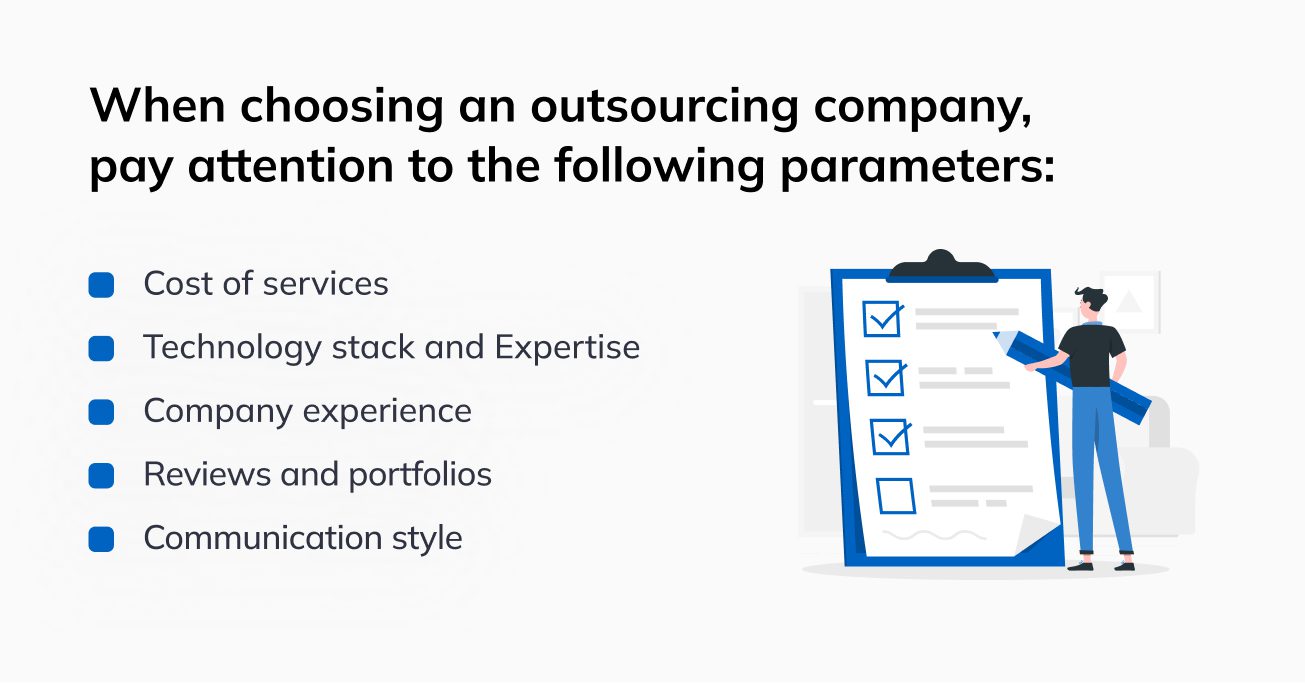
How To Build An Outsourced IT Department, Cut Costs And Maintain Quality?



Recent studies have shown that 57% of the largest companies in the Forbes G2000 rating use IT outsourcing services. What is the reason for the popularity of this model of IT department organization? In this article, we will discuss the advantages of outsourcing and the opportunities it brings for companies. We will also discuss what you should consider when choosing an outsourcing service provider. Do it smartly, and you will create a premium-quality digital product and save your budget at the same time.
Content
When a company faces a need to create new software and scale or support existing digital solutions, it has two options. The first is to create an in-house team of IT specialists. A very convenient choice since the team will always be in touch and fully immersed in the company’s internal processes. But there is a disadvantage to this hiring model. Yes, the costs. You will have to pay salaries to employees even when the project is not in progress, provide office space, and invest in the development and training of staff.
An alternative to this approach is to turn to outside specialists. Freelancers are cheaper, but they do not give any guarantees of the quality of the final product. On the other hand, outsourcing companies offer a reasonable price for their services and ensure the delivery of high-quality software.
IT Outsourcing is a hiring model that involves turning to a third-party provider for software development, scaling, or support.
So what goals do entrepreneurs pursue when they turn to outsource service providers? According to the data presented in the Deloitte Global Outsourcing Survey, 70% of companies primarily pursue financial gain. It is the primary goal, but it is by no means the only one.
Would you like a developer from one of the most progressive high-tech countries, like Japan, the USA, or South Korea, to join your team? Nothing is impossible with IT outsourcing. A provider will find a specialist with the required industry expertise and the technology stack for implementing your software wherever they are. High competition in outsourcing services guarantees that the company will go the extra mile to recruit the right pro.
There are several ways to save on outsourcing:
Even with an in-house team, you may need the services of a freelance developer. These situations happen when you are short of a specific subject matter expert. Or when you have an extra large project and the in-house team can’t release the product on time.
According to the Deloitte Global Outsourcing Survey, this goal is a priority for 20% of companies that use outsourcing services. Several factors speed up the delivery of software.
In addition to all of the above, technical outsourcing helps reduce the risks when developing a new digital solution. The specialists involved usually have extensive experience and can tell you how best to implement the customer’s idea.
If you have decided that turning to an outsourcing company is the best option for creating and maintaining your software, then it’s time to choose the best model and type of IT outsourcing. Where is it better to look for specialists: at home or abroad? When is it better to hire a freelancer for your team, and when to outsource the entire project? Let’s find out.

Depending on your business needs, an outsourcing service provider may offer specialists from different countries to work on your project. Every option has its advantages and disadvantages.
At Glorium Technologies, we are guided by your company’s needs and budget when choosing the type of outsourcing. We consider your wishes and location, then select the best specialists for your project.

Another classification of outsourcing by the cooperation model:
When choosing a model for engaging external developers, consider the scale of your project, the availability of an in-house team, and your desire to be directly involved in creating a digital solution.
The most popular categories of IT tasks to outsource:
The advantage of IT outsourcing is that you can determine which tasks to outsource to external specialists.
So, you are confident that outsourcing is just what you need for your project. You have decided on the type and model of cooperation and selected a list of tasks to outsource. Now the question is: Where do you start?
We have prepared a brief guide to help you through all the stages of creating an external IT department with minimal risks.
First, analyze your project and estimate tasks your internal team can’t do. Maybe it makes no sense to outsource the entire project, and you need to hire just one UI/UX designer.
If you have no experience in software development, you will need a technical project manager. This specialist can help you with provider selection and outsourcing models and, later on, will help reduce the risks.
Whether you want to save money or use innovative technology unavailable in your region, the supplier will help you reach your goal most efficiently.
It is essential to include hidden costs. You don’t want to find that you need more specialists or upgrade them in the middle of the project. Experienced outsourcing companies calculate all possible expenses beforehand.
Before looking for your ideal provider, think about what you want to achieve by working together. Then choose a company that meets your expectations.

We suggest dwelling on this point in more detail since it plays a key role. When choosing an outsourcing company, pay attention to the following parameters:
Foresee the possible losses with the help of competent risk management and take steps to minimize them. Possible risks include:
The list of steps for building an IT department may vary depending on the type and scale of your project. The recommendations listed above are the basics that will become your guide to outsourcing.
So, you have an idea for an innovative product but don’t have a team that can make it happen? Or maybe you need to scale an existing digital solution? Say no more! All you need is to outsource an IT department with the best professionals. Glorium Technologies will help you find developers for a project of any complexity. We are experts in delivering high-quality projects on time.
Yes, you can outsource all functions of the IT department. Contact an outsourcing provider who will select specialists with the necessary technological stack and expertise in your industry.
An outsourced IT department means you hire an outside company that will be responsible for all technical tasks of your company. Think software development from scratch, scaling or refining existing digital solutions, application testing, implementing DevOps methodology, and performing post-release maintenance and technical support of the system.
By turning to outsourcers, you can save your company’s budget, get access to global talent and innovative technologies, increase the speed of development and delivery of finished software, and reduce the burden on your in-house team by delegating some tasks to outside specialists.
When choosing an outsourcing company, look at the experience, team, and reviews. Compare the offers from several providers to pick the best price-to-quality ratio.








